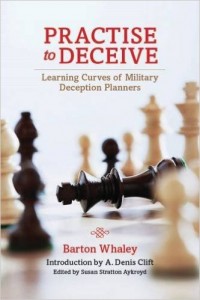Whaley, Barton. Practice to Deceive: Learning Curves of Military Deception Planners. Annapolis: Naval Institute Press, 2016, 256pp. $39.95.
By LT Robert “Jake” Bebber USN
Lawrence Freedman opens his magisterial tome “Strategy: A History” identifying the elemental features of strategy across time as “deception, coalition formation and the instrumental use of violence.”[i] It is no surprise that “deception” is the first essential element of strategy. “War is uncertain business,” as Whaley notes in his opening introduction, and “deception is the only weapon that a warrior can wield that, to the extent it succeeds, will impose uncertainty and the element of surprise on the opponent.” Deception is ultimately about surprising one’s enemy.
[otw_shortcode_button href=”https://cimsec.org/buying-cimsec-war-bonds/18115″ size=”medium” icon_position=”right” shape=”round” color_class=”otw-blue”]Donate to CIMSEC![/otw_shortcode_button]
Much has been written about deception and its importance in war, and Dr. Barton Whaley (1928-2013) is almost certainly one of the preeminent authorities on the matter. However, it is one thing to appreciate the importance of deception and entirely another to craft deception operations in support of military plans. Thankfully, Dr. Whaley has left us with a guide. Practise to Deceive [ii] is designed with the planners themselves in mind, providing insight into the type of thinking and procedures that make successful and unsuccessful deception planners. Early on, Whaley identifies the central role of commanders in deception planning and addresses important command and control issues, such as whether deception planning is best handled by the intelligence or operations cells in a military organization.
Those who work as physicians are said to “practice medicine” which conveys an important point. You may go to medical school, be awarded a medical degree and receive a license to work as a physician, but what truly makes you a good doctor is the constant repetition and experience of clinical practice. Deception is no different. A military course on deception planning is only the beginning. One must constantly practice and refine techniques, learn and study the art and science behind it. Since deception is ultimately about manipulating your opponent’s mind, the best practitioners are those who are well read in a broad variety of fields such as the natural sciences, biology, history, and psychology. Skills and knowledge atrophy over time. Indeed, from a broadly cultural perspective, Whaley notes entire tribes, countries and civilizations experience patterns of discontinuities, and in effect, have to relearn and rebuild from scratch. Our natural stereotypes about civilizations such as ancient Byzantium or modern China are “flat out wrong.”
Whaley’s analysis seeks to identify common traits of deception planners over time and provides useful observations. Excellence in deception is independent of rank, branch of service, or even military service. Deception planners tend to operate in small teams drawn from diverse backgrounds and experiences. They tend to have acute insight into both the enemy and their own side. Since the opportunities to actually use deception in war are rare over time, the study of past experience is critical. Finally – and probably most important – commanders must play an active part in deception planning. Ultimately, deception planning supports the commander’s goals and objectives, so his participation is key.
Practise to Deceive helps by providing the reader with 88 case studies of deception plans and operations. The book examines these cases from the perspective of the planners themselves. These case studies are broken up into four sections: cases of those who were in the early part of their career or new to deception, more experienced planners in specific operations, cases of how planners “sold” their commanders on deception plans, and finally deception planning at the institutional level. Most of these case studies are short, just three to ten pages in length.
In the later chapters, Whaley outlines the ten planning steps required for deception. These steps will lead the planner to determine what he wants the enemy to perceive and how he wants the enemy to react, considering the tools at his disposal. It lays out not only what the planner does but also how the planner thinks. In many ways, these steps mimic steps in writing creative fiction, storytelling, or screen play writing. Writing a deception plan is about leading an audience to reach a conclusion of the author’s choice. It just so happens that the author wants the audience to reach the wrong conclusion and ultimately be surprised.
It should come as no surprise to learn that Dr. Whaley’s life was more than just practicing and writing about military deception. He was an expert magician and lifetime member of the Magic Castle in Los Angeles and the International Brotherhood of Magicians, and a prize winning author on the subject. He brought his interest to the military in 2004, hosting workshops at the Naval Postgraduate School in Monterey, California, on magic and the military.

Whaley’s life and work should leave our senior military and national security leaders wondering whether our country is continuing to develop the talent and tools to practice good deception. This is critical to ensure not only that we can deceive our adversaries, but also help prevent us from being deceived (counter-deception). Deception, as both a practice and an art, is not something that one can master in a short time. It requires unique individuals who have to be recruited, trained, cultivated, and provided the opportunity to practice their craft. To practice deception, we must better incorporate deception planning and operations into exercises, training and war-games at all levels from tactical to strategic. Whaley concludes Practise to Deceive with this same advice, recommending that the U.S. consider the Israeli model to train both deception and counter-deception. History suggests that constantly having to relearn deception whole cloth comes at great cost. Ideally, we will take steps to keep the butcher’s bill small. Dr. Barton Whaley’s book is an excellent place to start.
LT Robert “Jake” Bebber USN is an information warfare officer assigned to the staff of U.S. Cyber Command. The views expressed here do not represent those of the Department of Defense, the Department of the Navy or U.S. Cyber Command. He welcomes your comments at [email protected].
[i] Lawrence Freedman. Strategy: A History (Oxford University Press: New York, 2013).
[ii] The book uses the British spelling of “Practise” instead of the American spelling.
[iii] From Dr. Barton Whaley’s obituary, available at: http://obits.dignitymemorial.com/dignity-memorial/obituary-print.aspx?n=Barton-Whaley&lc=6922&pid=166273115&mid=5624174
[otw_shortcode_button href=”https://cimsec.org/buying-cimsec-war-bonds/18115″ size=”medium” icon_position=”right” shape=”round” color_class=”otw-blue”]Donate to CIMSEC![/otw_shortcode_button]

